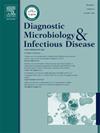Lethal Case of Microbacterium paraoxydans Bloodstream Infection Associated with Mitral Endocarditis in Human: A Case Report, analyses of the 16S rDNA sequences and review of the literature
IF 2.1
4区 医学
Q3 INFECTIOUS DISEASES
Diagnostic microbiology and infectious disease
Pub Date : 2025-02-08
DOI:10.1016/j.diagmicrobio.2025.116739
引用次数: 0
Abstract
Introduction
Microbacterium species are gram-positive, non-fermentative, yellow-pigmented rods commonly found in animals and various environmental sources. Herein is reported the first case of a fatal bloodstream infection associated with mitral endocarditis caused by Microbacterium paraoxydans in a human patient.
Methods
A 64-year-old man without significant infectious risk factors, except for rheumatoid spondylarthritis treatment, developed severe chest pain, paralysis of the left leg, respiratory distress, and high fever. Diagnostic investigations revealed ischemic stroke and mitral insufficiency. Despite valve replacement surgery and antibiotic treatment, the patient's condition deteriorated, resulting in valve disinsertion, pneumopathy, and death.
Results
Blood cultures taken later confirmed the presence of Microbacterium sp., identified as M. paraoxydans by 16S rDNA gene sequencing.
Conclusion
This case highlights the importance of using sequencing for accurate identification of Microbacterium species. This report emphasizes the need for research and surveillance to understand the clinical characteristics, treatment strategies, and impact of Microbacterium infections in humans.
求助全文
约1分钟内获得全文
求助全文
来源期刊
CiteScore
5.30
自引率
3.40%
发文量
149
审稿时长
56 days
期刊介绍:
Diagnostic Microbiology and Infectious Disease keeps you informed of the latest developments in clinical microbiology and the diagnosis and treatment of infectious diseases. Packed with rigorously peer-reviewed articles and studies in bacteriology, immunology, immunoserology, infectious diseases, mycology, parasitology, and virology, the journal examines new procedures, unusual cases, controversial issues, and important new literature. Diagnostic Microbiology and Infectious Disease distinguished independent editorial board, consisting of experts from many medical specialties, ensures you extensive and authoritative coverage.

 求助内容:
求助内容: 应助结果提醒方式:
应助结果提醒方式:


